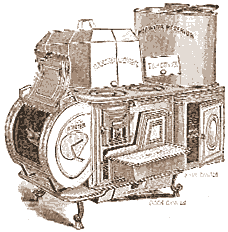 1860 |  1870 |  1880 |  1890 |  1900 |
 1910 |
 1860 |  1870 |  1880 |  1890 |  1900 |
 1910 |
|
Eggbeater with rack-and-pinion movement |
1860s New Foods.
|
1860s New Food Companies.
|
1860s Food Industry Beginnings.
|
1860s Farming Progress.
|
1860s
VICTORIAN RECIPES.
Miscellaneous Receipts, 1864. |  Beat the whites of nine fresh eggs to a stiff froth, then mix with it fifteen spoonfuls of finest white sugar, and five or six drops of essence of lemon. Drop them on paper with a teaspoon, sift sugar over them, and bake them in a slow oven. Beat the whites of nine fresh eggs to a stiff froth, then mix with it fifteen spoonfuls of finest white sugar, and five or six drops of essence of lemon. Drop them on paper with a teaspoon, sift sugar over them, and bake them in a slow oven."Directions for Making Cake," American Recipes from 1864.
"On Cooking Vegetables," American Recipes from 1864. "Our New Cook-Book," Peterson's Magazine, 1868. |
"The most common modes of cooking, where open fires are relinquished, are by the range and the cooking-stove ...this stove, left, ...with proper management of dampers,  one ordinary-sized coal-hod of anthracite coal will, for twenty-four hours, keep the stove running, keep seventeen gallons of water hot at all hours, bake pies and puddings in the warm closet, heat flat-irons under the back cover, boil tea-kettle and one pot under the front cover, bake bread in the oven, and cook a turkey in the tin roaster in front." The American Woman's Home, by Catherine E. Beecher and Harriet Beecher Stowe, 1869.
one ordinary-sized coal-hod of anthracite coal will, for twenty-four hours, keep the stove running, keep seventeen gallons of water hot at all hours, bake pies and puddings in the warm closet, heat flat-irons under the back cover, boil tea-kettle and one pot under the front cover, bake bread in the oven, and cook a turkey in the tin roaster in front." The American Woman's Home, by Catherine E. Beecher and Harriet Beecher Stowe, 1869.
| More Kitchens. | |||||
 1860 |  1870 |  1880 |  1890 |  1900 |
 1910 |
| Cookbooks | House-Plan Books | Samples | Site Index | Home |